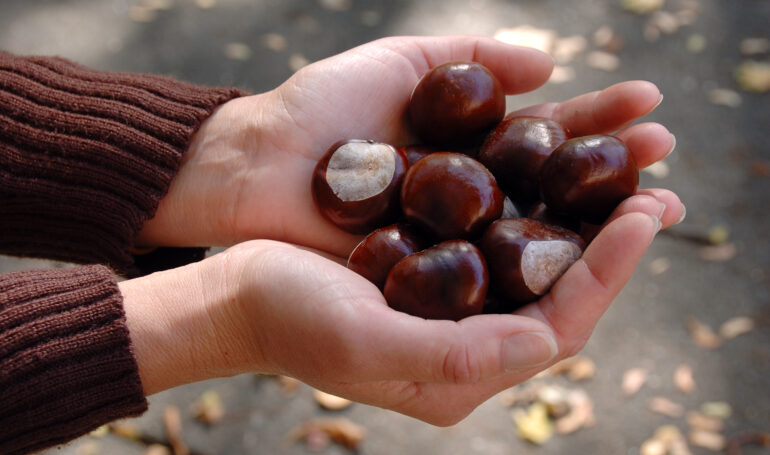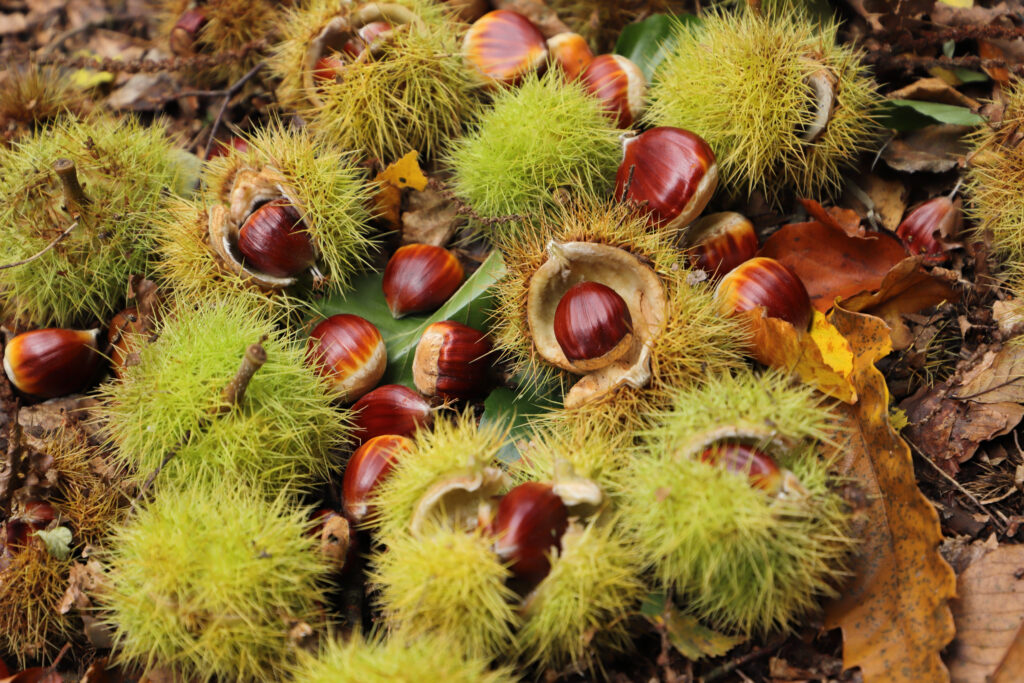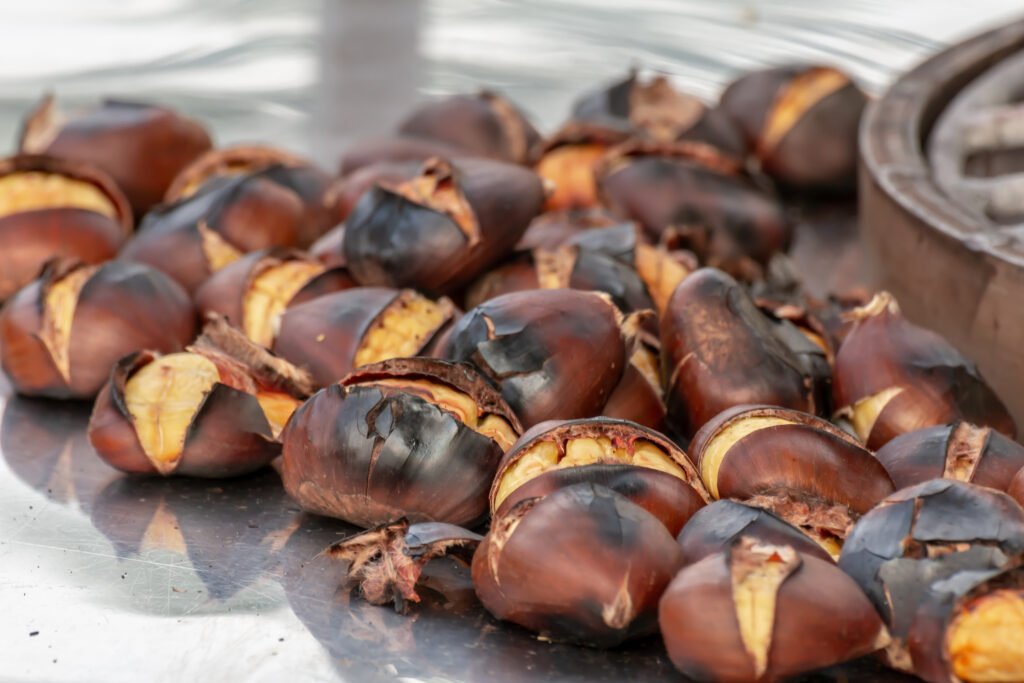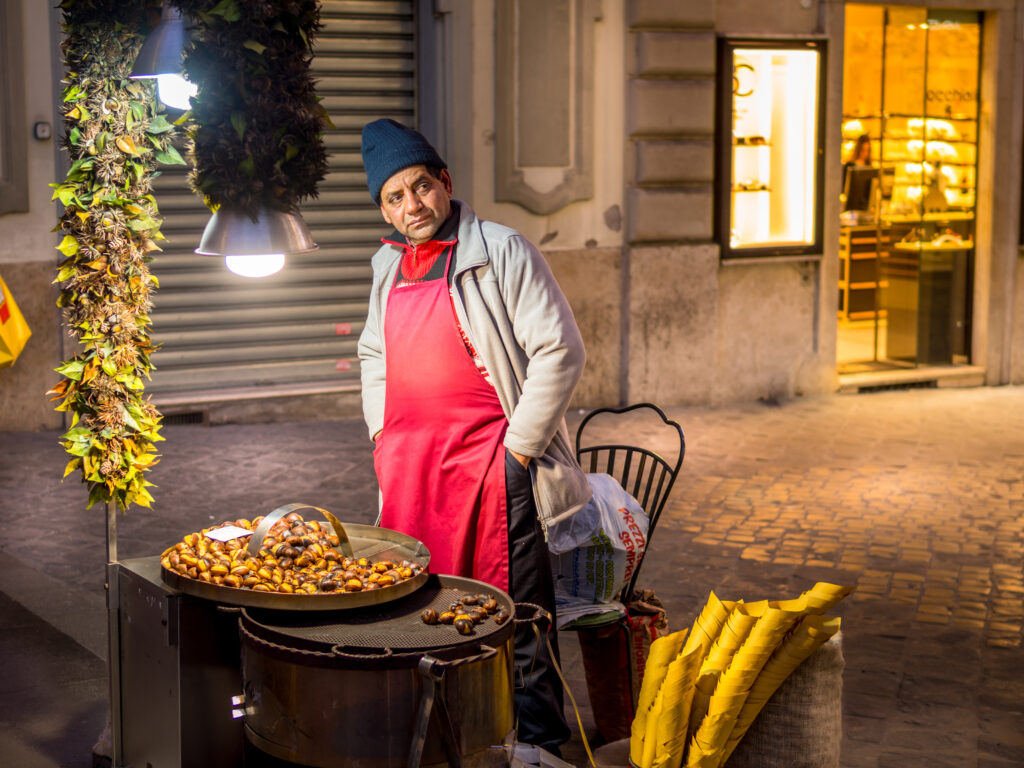
All About Chestnuts!
When it comes to food and cooking, fall and winter are definitely my favorite seasons. You’re more likely to find me in the kitchen during the cooler months. I love warming up the house by turning on the oven and cooking a large family meal, with plenty of leftovers for the following day.
One of my all-time favorite treats this time of year is chestnuts. They are the symbolic fruit (yes, it’s a fruit) of autumn, and they are delicious and also have many beneficial properties.
The chestnut is a prevalent tree in central and southern Europe. It tolerates low temperatures well and is only damaged by very intense cold. Fruits need time to ripen and need little rain. Chestnuts are enclosed in a very prickly shell and protected by a brown peel and can thus be harvested in late September, October, and November. The grocery store ones have had their outer prickly shell removed.

In Italy, there are about a hundred varieties of chestnuts. Each fruit’s caloric value is high, so isn’t it so for everything delicious? Three or so ounces of shelled chestnuts contain close to 200 calories. However, this caloric intake tends to drop if they are boiled. The same amount of boiled chestnuts contains about 120 calories. Chestnuts are rich in complex carbohydrates, fiber, vegetable proteins, and mineral salts. They offer an excellent supply of B vitamins and, of course, do not contain cholesterol. Their nutritional profile makes them the perfect health ally, placing them on my fall shopping list. You will always find them on my Thanksgiving dinner table.
Among the recognized benefits of chestnuts, you’ll be happy to learn that they contribute to gut health, circulation, and the nervous system. Their energy boost makes them excellent for fighting stress and fatigue. The high iron content makes chestnuts a valid food to combat anemia. The folic acid contained in these fruits is also ideal for pregnant women. While eating them raw is acceptable, they can be difficult to digest, so it’s advised to enjoy them cooked in some fashion. But what are the options for cooking them? We are used to roasted chestnuts, (que in the famous song) but they can be prepared in a few different ways.
Oven Roasted Chestnuts
For oven-roasted chestnuts, the procedure is straightforward and relatively fast. With a paring knife, gently and carefully mark each chestnut’s flat side with a straight line or an X, cutting through the skin. This will prevent them from popping while they cook. Place the now-branded chestnuts on a baking sheet and roast them at 375 ° C for about 25 – 30 minutes, shaking the pan several times so they roast evenly. When finished, place the chestnuts in a paper bag or wrap them in a damp cloth and let them rest for five minutes. The steam will soften the skin, making peeling easier.

Boiled Chestnuts
Boiled chestnuts are a great way to avoid the smoky notes of roasting. In addition, the cooked fruit can also become the basis for a delicious dessert. Add mascarpone cream or whipped cream to the chestnut puree. After washing and scoring the fruits, boil some water, adding a little coarse salt and, to taste, other aromas such as bay leaves or orange peel. Add the chestnuts and cook them on medium heat. Every pound of fruit will take about 45 minutes of cooking time. Cool them slightly before peeling and enjoying them.
Microwaved Chestnuts
Preparing chestnuts in the microwave is also an option. After cleaning and scoring the fruit, as noted above, soak them in water for 10 minutes. Drain them and arrange them on the microwave plate. Cook at 800W for 5 minutes. Once out of the microwave, place them in a paper bag for five minutes to make peeling easier. It’s critical that they are scored before microwaving them, or they will undoubtably pop in the microwave, causing a large mess.
Stove-Top Chestnuts
If you do not want to use a classic method of roasting them or the microwave oven or to wait the necessary time for boiling, cook the chestnuts in a pan over the stovetop. You will need a unique cooking pan with holes to prepare them perfectly. Click here for the pan (or something similar) I recommend using. Proceed with cleaning and scoring the fruit. After that, cook them in a pan over medium-low heat for about 15 minutes. Turn them often to ensure even cooking. After cooking, wrap them in a damp cloth to facilitate peeling. You can also use this method and pan to cook them on the grill!
In Conclusion
Chestnuts are the epitome of fall for me, and while they can be a bit labor-intensive, I wouldn’t think of not having them on my dinner table several times during the fall season into December. They are healthy comforting, and go deliciously well with a glass of wine.

Leave a Reply

What to Pack for Italy
Cosa Mettere in Valigia per l'Italia
Everyone is always asking me what they should pack for Italy,
so I’ve created a quick reference guide that you can use for your next trip.
Hint: You don’t need nearly as much as you think you do!

5 Comments
As a child my mother would start roasting Chestnuts in the fall. We would gather around the table to enjoy this delightful fruit.
As I got older the Sons of Italy would have a Chestnut dance and yes again I enjoyed the Chestnuts, Good Memories.
Love chestnuts
Thanks so much for introducing me of all the ways to make them
I always just roasted them in the oven
Ciao
Annette
Roasting chestnuts is one of my family traditions. I always think of my Dad when I see chestnuts. It was one of his favorite things to eat, and mine as well.
Thank you. Our tree has it’s first big crop.
Chestnuts are a wonderful treat that I always knew about, but never had until I saw them in a shop in Lisbon, Portugal. Baked them and been a fan ever since.